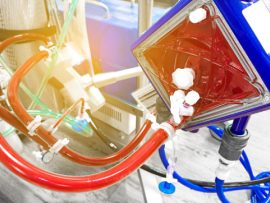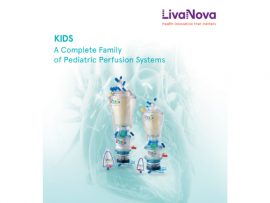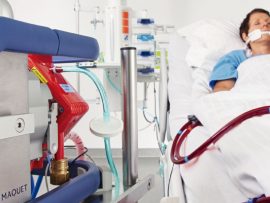Abstract Chronic respiratory diseases claim nearly four million lives annually, making them the third leading cause of death worldwide. Extracorporeal membrane oxygenation (ECMO) is often the last line of support..
Read MoreAbstract This review examines the role of extracorporeal membrane oxygenation (ECMO) in the management of severe acute respiratory distress syndrome (ARDS), emphasizing its contribution to lung-protective ventilation through optimizing oxygenation..
Read MoreAbstract The geometric configuration of fiber bundles plays a critical role in gas transfer for membrane oxygenators; however, experimentally studying its impact on gas transfer distribution is challenging. This study..
Read MoreAbstract Purpose: The selection and intensity of respiratory support for ARDS are guided by PaO 2/FiO2 . However, ventilator-induced lung injury (VILI) is linked to respiratory mechanics and ventilator settings...
Read MoreAbstract Background The continuous exposure of blood to a non-biological surface during extracorporeal membrane oxygenation (ECMO) may lead to progressive thrombus formation in the oxygenator, hemolysis and consequently impaired gas..
Read MoreAbstract Introduction Oxygenators for paediatric Extracorporeal Membrane Oxygenation (ECMO) are required to operate over a wide range of flow rates, in a patient group ranging from neonates through to fully..
Read MoreAbstract Circulating venous blood outside the body, through an artificial lung (membrane oxygenator), andreturning oxygenated blood to the patient is extracorporeal gas exchange. Oxygen and carbondioxide exchange in a membrane..
Read MoreAbstract Introduction The performance of an oxygenator, as found in literature, is evaluated according to protocols that define standard values of the gas content in the inlet blood. However, when..
Read MoreAbstract Objectives Extracorporeal life support (ECLS) pertains to therapeutic and prophylactic techniques utilized in a wide range of medical applications, with severe pulmonary diseases being the most prominent cases. Over..
Read MoreAbstract Dual circulation is a common but underrecognized physiological occurrence associated with peripheral venoarterial extracorporeal membrane oxygenation (ECMO). Competitive flow will develop between blood ejected from the heart and blood..
Read More







